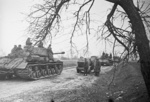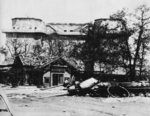Iosif Stalin
| Country | Russia |
| Manufacturer | Kirov Factory, UZTM, Yekaterinburg, Russia |
| Primary Role | Heavy Tank |
Contributor: C. Peter Chen
ww2dbaseThe Iosif Stalin tanks, often abbreviated to IS tanks, were heavy tanks that came out of Marshal Kliment Voroshilov's KV-13 design program. The resulting design was named after the Russian leader Joseph Stalin instead of Voroshilov because the marshal had fallen out of political favor by the time the design program concluded. The IS-85 prototype was accepted for production with the new designation IS-1, but the primary weapon of 85-millimeter caliber was considered too small, thus production was limited while a better weapon was being selected. IS-100 prototype with a BS-3 100-millimeter gun was field tested alongside of IS-122 prototype with an A-19 122-millimeter gun, and the latter proved to possess better armor penetration capabilities, thus IS-122 prototype was accepted as the IS-2 variant design and the first actual production variant. The few IS-1 tanks made were sent back to the factory and re-armed as IS-2 tanks. Unlike their predecessors of the KV-series heavy tanks, the IS-2 tanks were lighter, but the armor was better shaped and focused more heavily in the front of the tanks. The A-19 guns had very good armor penetration capabilities, meanwhile they were also capable of delivering large high explosive shells against bunkers and anti-tank guns; the blessing was also a curse, however, as the larger two-part shells were difficult to handle and thus leading to a low firing rate.
ww2dbaseThe IS-2 heavy tanks entered service in Apr 1944. Usually 21 IS-2 tanks made up a regiment, and were usually used largely as breakthrough tanks fighting at the spearhead of offensives. They were often charged with destroying fortifications and anti-tank guns, creating holes in German lines for the medium tanks and infantry behind them to exploit. Their thick armor was difficult to penetrate by the German 88-millimeter anti-tank guns that, up until this time, were among the more feared weapons for Russian tank crews. In Aug 1944, near the town of Sandomierz, Russia (now Poland), 11 IS-2 heavy tanks of the Russian 71st Guards Independent Heavy Tank Regiments defended an attack by 14 Tiger II heavy tanks of the German 105th Heavy Panzer Regiment, which was the first time the two heavy tanks met; four of the Tiger II heavy tanks were destroyed as the Russians held their ground at the cost of 3 destroyed and 7 damaged IS-2 tanks.
ww2dbaseIn mid-1944, some IS-2 heavy tanks were made with D25-T 122-millimeter guns. They were dubbed as IS-2 model 1944 tanks. In late 1944, the IS-3 variant design was completed. The IS-3 tanks had thicker front armor at 200-millimeter (compared to IS-2 tanks' 120-millimeter) and new cast turrets that lowered the overall height at the cost of limited working space within the turrets. By the time they entered production, Germany had already surrendered. However, one regiment of IS-3 heavy tanks might have participated as breakthrough tanks during Operation August Storm against Japanese forces in Manchukuo/Manchuria, China.
ww2dbaseIn 1952, the IS-10 development program was completed but was renamed T-10 due to Stalin's death in 1953; they had longer hulls, seven pairs of road wheels instead of six, larger turrets with a new gun with fume extractor, improved diesel engines, and increased armor. In 1956, Russian IS-3 heavy tanks were used during the invasion of Hungary. In the mid-1950s, remaining IS-2 heavy tanks were upgraded and re-designated IS-2M; the upgrade included the fitting of external fuel tanks on the rear hull, stowage bins on both sides of the hull, and protective skirting along the top edges of the tracks. IS-3 heavy tanks were also slightly modernized as IS-3M. In 1967, during the Six-Day War, Egypt operated IS-2 heavy tanks against Israeli IDF M48 Patton medium tanks. In 1968, during the Prague Spring political liberalization period in Czechoslovakia, Russian forces entered occupied the country with IS-3 heavy tanks leading the invasion force; the Russian occupation forces would remain until 1990. In the late 1960s, as main battle tanks made heavy tanks obsolete in the prior decade, Russian heavy tanks generally were transferred to the reserve forces or to storage facilities, but IS-2 tanks operated by Cuba, China, and North Korea remained in service for much longer.
ww2dbase3,854 IS-2, 2,311 IS-3, and 250 IS-4 heavy tanks were built.
ww2dbaseSource: Wikipedia.
Last Major Revision: Feb 2009
SPECIFICATIONS
IS-2 Model 1944
| Machinery | V2 12-cylinder diesel engine rated at 600hp |
| Suspension | Torsion Bar |
| Armament | 1x122mm D25-T gun (28 rounds), 2x7.62mm DT machine guns, 1x12.7mm AA DShK machine gun |
| Armor | 160mm front |
| Crew | 4 |
| Length | 9.90 m |
| Width | 3.09 m |
| Height | 2.73 m |
| Weight | 46.0 t |
| Speed | 37 km/h |
| Range | 240 km |
IS-4 Objekt 245
| Machinery | V2 12-cylinder diesel engine rated at 600hp |
| Suspension | Torsion Bar |
| Armament | 1x100mm D10-T gun, 2x7.62mm DT machine guns, 1x12.7mm AA DShK machine gun |
| Armor | 160mm front |
| Crew | 4 |
| Length | 9.90 m |
| Width | 3.09 m |
| Height | 2.73 m |
| Weight | 46.0 t |
| Speed | 37 km/h |
| Range | 240 km |
Photographs
 |  |  |  |
Please consider supporting us on Patreon. Even $1 per month will go a long way! Thank you. Please help us spread the word: Stay updated with WW2DB: |
Visitor Submitted Comments
17 Nov 2010 01:20:07 PM
After WWII the IS-2 continued to serve the
Red Army. In the 1950s suviving vehicles
were upgraded, to keep pace with the West.
It was powered by a 12-cylinder diesel engine of 500hp.
It was armed w/ 1x122mm gun and 2x7.62mm
machine guns, and 1x12.7mm heavy machne gun
The IS-3 Heavy Tank entered production before
the end of WWII. Carried 1x122mm gun and
1 or 2x7.62mm machine guns, one 1x12.7mm
heavy mchine gun. It was powered by a 600hp
12-cylinder diesel engine.
7 Nov 2013 12:31:35 PM
I just thought it was worth noting that the tank pictured at the top of the page is an IS-7. It was not mentioned in the article, but the IS-7 was developed in 1948 and never passed the prototype stage.
1 Oct 2015 02:01:22 AM
Hmm, may I respectfully ask for the specifications for the IS-4? even though I read that the IS-4 is essentially an improved IS-2. I would personally like the specs on the IS-4. Please it will be of great help
All visitor submitted comments are opinions of those making the submissions and do not reflect views of WW2DB.

» King Tiger vs IS-2
- » 1,182 biographies
- » 337 events
- » 45,119 timeline entries
- » 1,248 ships
- » 350 aircraft models
- » 207 vehicle models
- » 376 weapon models
- » 123 historical documents
- » 261 facilities
- » 470 book reviews
- » 28,409 photos
- » 365 maps
George Patton, 31 May 1944
Please consider supporting us on Patreon. Even $1 a month will go a long way. Thank you!
Or, please support us by purchasing some WW2DB merchandise at TeeSpring, Thank you!
9 Aug 2010 09:00:31 AM
The IS-2, Model 1944 started it's service
with the Red army in April 1944.
This heavy tank, was designed to take on the
German Tiger tank, German tiger crews crews
were shocked when they saw the IS-2 take the
incoming fire, with little battle damage.